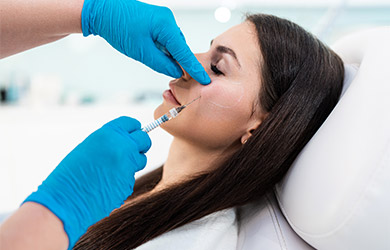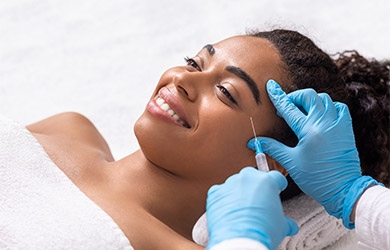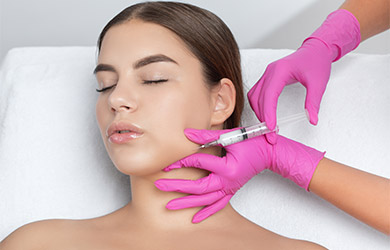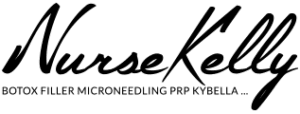
Conveniently located on Seven Mile Beach, Grand Cayman

Experience the rejuvenating benefits of Sculptra, an innovative dermal filler enriched with poly-L-lactic acid that stimulates collagen production, fostering natural fullness and smoothing skin texture. Distinguished from traditional fillers, Sculptra’s gradual approach ensures subtle, enduring enhancements. In our clinic, Nurse Kelly collaborates with Dr. Christoffersen to bring the artistry of Sculptra to fruition for a naturally revitalized glow.
Whether you seek to enhance volume, diminish wrinkles, or achieve a more youthful complexion, our clinic offers a personalized and professional approach to dermal fillers, including Sculptra. With Nurse Kelly’s expertise and the collective experience of our team at Cayman Doctors, rest assured that your aesthetic goals, including Sculptra treatments, will be met with precision and care, unveiling a radiant and revitalized version of yourself.
To learn more about Sculptra, please don’t hesitate to contact our clinic at 1 (345) 943-6363 to learn more about Sculptra or book an . We are located at West Shore Center (Pink Plaza), 508 West Bay Road, PO Box 32078, Grand Cayman KY1-1208, Cayman Islands, B.W.I.
Elevate your skincare journey with Nurse Kelly and our team of skilled practitioners at Cayman Doctors, where cutting-edge dermal fillers are expertly administered to address a myriad of skin concerns. Book a consultation with our expert team to discover the perfect Sculptra solution for your skin’s distinct needs.
Fast Facts
Who’s it for?
Sculptra is suitable for individuals seeking non-surgical facial rejuvenation, particularly for addressing volume loss, wrinkles, fine lines, and acne scars.
Similar products:
Radiesse, Restylane
Celebs who swear by it:
Kylie Jenner, Kim Kardashian, Victoria Beckham
What is Sculptra?
Sculptra is a dermal filler designed to address signs of aging, particularly volume loss and wrinkles on the face. The key ingredient in Sculptra is poly-L-lactic acid, a biocompatible substance known for stimulating collagen production. Administered through injections, Sculptra works gradually to enhance facial volume and improve skin texture, offering a more natural and long-lasting result compared to some other fillers.
How Sculptra Works

Sculptra works by stimulating the body’s collagen production, a vital protein responsible for maintaining skin elasticity and volume. Poly-L-lactic acid, the main component, encourages the gradual replenishment of collagen, leading to improved skin structure and diminished wrinkles over time. The treatment involves a series of injections strategically placed to achieve optimal results, offering a more subtle and natural enhancement compared to traditional dermal fillers.
Advantages of Sculptra
The primary advantages of Sculptra are:
- Increased Collagen Production: Sculptra contains poly-L-lactic acid, which stimulates the production of collagen in the skin.
- Gradual and Subtle Results: Results with Sculptra are gradual and subtle, allowing for a more natural appearance over time.
- Long-Lasting Effects: The collagen stimulation induced by Sculptra can provide longer-lasting results (effects may last up to two years or more) compared to some other dermal fillers.
- Versatility: Sculptra can be used to address various facial areas, including cheeks, temples, and jawline, providing overall facial rejuvenation.
- Non-Surgical and Minimally Invasive: Sculptra is administered through injections, making it a non-surgical and minimally invasive procedure.
- Customizable Treatment Plans: Sculptra treatments can be customized to meet individual aesthetic goals.
- Safe and FDA-Approved: Sculptra has been approved by the U.S. Food and Drug Administration (FDA) for cosmetic use, indicating its safety and efficacy.
- Natural-Looking Results: Since Sculptra works by enhancing the body’s natural collagen production, the results tend to look and feel more natural than some other fillers.
- Little to No Downtime: Sculptra treatments typically require little to no downtime, allowing individuals to resume their normal activities shortly after the procedure.
- Complementary to Other Treatments: Sculptra can be used in combination with other aesthetic procedures to achieve a comprehensive facial rejuvenation strategy.
What Brands Do We Use?
Our clinic exclusively utilizes Sculptra, a trusted and FDA-approved brand known for its efficacy in addressing volume loss and skin aging. By focusing on this specific brand, we ensure that our patients receive the highest quality treatment with a product recognized for its safety and effectiveness.
Risks and Complications of Sculptra
While Sculptra is generally considered safe, like any medical procedure, it carries some risks. Potential complications may include:
- bruising
- swelling
- tenderness
- the formation of nodules
It’s essential to consult with a qualified healthcare professional. Nurse Kelly collaborates closely with Dr. Christoffersen to enhance the safety and effectiveness of Sculptra treatments. Her expertise is invaluable in mitigating potential risks and complications associated with the procedure. By delivering personalized advice, conducting thorough assessments of individual risks, and engaging in discussions about potential side effects, Nurse Kelly ensures a comprehensive and informed approach to Sculptra treatments. This collaborative synergy between Nurse Kelly and Dr. Christoffersen underscores the commitment to achieving optimal aesthetic results while prioritising patient well-being.
What to Expect Before Sculptra

Before undergoing Sculptra treatment, patients can expect a thorough consultation with a healthcare professional. This involves discussing medical history, addressing concerns, and setting realistic expectations. Pre-treatment instructions may include avoiding certain medications and substances to minimize the risk of complications.
What to Expect During Sculptra
Before the injection process, a numbing cream or local anesthetic may be applied to the treatment area/s to ensure optimal comfort. During the Sculptra procedure, the healthcare professional will administer the injections according to the planned treatment areas. The process is relatively quick, and while some discomfort may occur, it is typically well-tolerated. Patients can resume their normal activities after the session, making Sculptra a convenient option for those with busy lifestyles.
Sculptra Recovery Time
One of the notable advantages of Sculptra is its minimal downtime. While some swelling or redness may occur immediately after the injections, these side effects are usually temporary and resolve within a few days. Patients undergoing the treatment with Nurse Kelly can generally return to their regular activities post-treatment, with any residual effects easily manageable with makeup.
Conditions Treated by Sculptra
Sculptra is commonly used to address various cosmetic concerns associated with facial aging and volume loss.
Fine Lines and Wrinkles
Sculptra treats fine lines and wrinkles by stimulating the body’s natural collagen production. The main component, poly-L-lactic acid, encourages the gradual replenishment of collagen, improving skin texture and elasticity over time. As collagen levels increase, fine lines and wrinkles are reduced, resulting in a smoother and more youthful appearance.
A study reported that Sculptra, an injectable poly-L-lactic acid, is recognized for its success in correcting lipoatrophy (the localized loss of fat tissue) in Europe. [1] Unlike traditional methods, Sculptra’s mechanism emphasizes returning volume to facial areas, making it effective for treating nasolabial folds, mid and lower facial volume loss, jawline laxity, and other signs of aging. This minimally invasive treatment offers prolonged facial enhancement (18-24 months), with a low risk of side effects and no need for allergy testing, revolutionizing the approach to facial rejuvenation.
A study evaluated the safety and efficacy of injected poly-L-lactic acid (PLLA) for enhancing rhytids (wrinkles or fine lines) and crepiness in the décolletage (the upper part of the torso). [2] In this study, 25 healthy females aged 40 to 70 with moderate-to-severe crepiness and wrinkles received three treatments of PLLA injections. Both investigators and subjects utilized the Fabi-Bolton 5-point chest wrinkling scale for pretreatment and post-treatment assessments at 1, 3, and 6 months. The results revealed statistically significant improvement, with 83% of subjects showing improvement at 1 month, and 90% at 6 months, indicating PLLA’s safety and effectiveness in enhancing photodamaged décolletage skin quality.
A study compared the efficacy and safety of injectable poly-L-lactic acid (PLLA) with human-derived collagen in addressing nasolabial fold wrinkles. [3] In this study, subjects received either injectable PLLA or collagen injections over 1-4 visits at 3-week intervals. Injectable PLLA demonstrated significantly improved mean Wrinkle Assessment Scale scores at all time points, with greater and longer-lasting improvements (up to 25 months after the last treatment) compared to collagen for post-treatment months 3 to 13. The findings suggest that injectable PLLA is a well-tolerated, effective, and enduring solution for nasolabial fold wrinkle correction.
Treatment Options
Sculptra stimulates collagen production, addressing fine lines and wrinkles by gradually replenishing volume and improving skin texture for a natural and long-lasting enhancement.
Sunken Cheeks
Sunken cheeks refer to a condition where the natural fullness in the lower part of the cheeks diminishes, creating a hollow or concave appearance. This can occur due to factors such as aging, weight loss, or a reduction in facial fat. Sunken cheeks can contribute to an aged or tired look.
Sculptra treats sunken cheeks by stimulating collagen production in the skin. When injected into the targeted areas, Sculptra’s main component, poly-L-lactic acid, prompts the gradual regeneration of collagen, restoring volume and improving the overall contour of the cheeks. This process provides a natural-looking and long-lasting enhancement, addressing the appearance of sunken cheeks and contributing to a more youthful facial profile.
In one study, the safety and long-term efficacy of Poly-L-lactic acid (PLLA) in treating age-related sunken cheeks in Asians were evaluated. [4] Eleven subjects received three sessions of PLLA and were followed up for 24 months. Despite a high incidence of bruising (63.7%) and post-treatment nodules (27.3%), 90.9% of patients reported satisfaction and 91% rated the volume correction as good or excellent, highlighting PLLA’s long-lasting effects and high patient satisfaction in reversing age-related sunken cheeks in the Asian population.
In another study, HIV-positive individuals with facial lipoatrophy were randomized to receive immediate or delayed poly-L-lactic acid (PLLA) injections over a 16-week period, with assessments conducted at weeks 0, 12, and 24. [5] All 30 patients completed the 24-week treatment and injections were well-tolerated, resulting in only two recorded adverse events. Immediate-treatment patients showed significantly better visual analogue scores and lower anxiety scores at week 12 compared to delayed-treatment patients, with benefits persisting until week 24. Overall, PLLA injections demonstrated improvements in patient self-perception and mental well-being, with uncommon adverse events and sustained benefits for at least 18 weeks beyond the last injection.
A study evaluated the efficacy and safety of facial injections of poly-L-lactic acid (PLLA) in HIV-infected patients with severe facial lipoatrophy. [6] Fifty patients received four sets of injections over a 6-week period and were assessed at various time points up to week 96. The results demonstrated a significant increase in total cutaneous thickness, with aesthetic improvements observed throughout the study. The study concluded that PLLA effectively corrected facial lipoatrophy in HIV-infected patients, showcasing its potential as an attractive treatment option with a favorable safety profile and simple injection schedule.
Treatment Options
Sculptra treats sunken cheeks by stimulating collagen production, gradually restoring volume to the targeted areas and improving overall facial contour for a natural and long-lasting enhancement.
Acne Scars
Sculptra can be used to treat certain types of acne scars by stimulating collagen production and improving overall skin texture. When injected into the affected areas, Sculptra’s poly-L-lactic acid works to rebuild collagen, filling in depressions caused by acne scars. The gradual collagen regeneration can lead to a smoother and more even skin surface, reducing the appearance of acne scars over time.
A study evaluated the novel application of injectable poly-L-lactic acid (PLLA), specifically Sculptra, for correcting acne scars in a 60-year-old white woman who had previously undergone various treatments without satisfactory improvement. [7] The patient received seven sessions of injectable PLLA into individual scars and depressions in the nasolabial folds, mid-cheeks, and chin, resulting in observable improvement six months after the last session. Well-tolerated with minimal swelling and bruising, this case suggests that injectable PLLA could offer an enhanced treatment modality for addressing challenging acne scars.
In another study, twenty participants with facial scars from moderate to severe acne or varicella received serial injections of poly-L-lactic acid (PLLA) reconstituted with sterile water without topical anesthesia. [8] Over the course of seven treatments, there were significant reductions in both the size and severity of acne scars as assessed by the investigator and participants. Subject satisfaction trended upwards with each session and adverse events were limited to one case of depression unrelated to the treatment, suggesting that injectable PLLA effectively corrects acne scars with minimal adverse effects.
A study determined the correction achievable with poly-L-lactic acid in treating hill and valley acne scarring. [9] Twenty-two subjects underwent 3 to 4 serial treatments at 4-week intervals and assessments included evaluations by physicians, blinded evaluators, and subjects, comparing photographs from three camera systems. Results indicated a notable percentage of patients (45.5% to 68.2%) showing much to excellent improvement, with a 44% increase in subject treatment satisfaction. The treatment was well-tolerated, with only one patient experiencing a palpable nonvisible nodule and no discontinuations, suggesting that injectable poly-L-lactic acid effectively improves hill and valley acne scarring with good tolerance.
Treatment Options
Sculptra treats acne scars by stimulating collagen production, gradually improving skin texture and promoting tissue regeneration for a smoother and more refined appearance.
Question & Answer
How is Sculptra different from other fillers?
Sculptra’s unique approach stimulates collagen over time, offering subtle, long-lasting results distinct from traditional fillers.
Who is an ideal candidate for Sculptra?
An ideal candidate for Sculptra is an individual seeking a gradual and subtle improvement in facial volume and contour, particularly those with age-related volume loss or contour deficiencies.
How long do Sculptra results last?
Sculptra’s effects can last up to two years or more, making it a durable choice for facial enhancement.
How many Sculptra treatments are typically needed?
The number of sessions varies, but a series of treatments, usually three to four, spaced a few weeks apart, is common.
Is Sculptra safe?
Yes, Sculptra is FDA-approved and considered safe when administered by qualified healthcare professionals.
Does Sculptra require downtime?
Downtime is minimal; patients can generally resume regular activities after treatment.
Are Sculptra injections painful?
The discomfort is minimal and topical anesthesia can be applied to enhance comfort during the procedure.
References
- Vleggaar D, Bauer U. Facial enhancement and the European experience with Sculptra (poly-l-lactic acid). J Drugs Dermatol. 2004 Sep-Oct;3(5):542-7. PMID: 15552606. Retrieved from https://pubmed.ncbi.nlm.nih.gov/15552606/.
- Wilkerson EC, Goldberg DJ. Poly-L-lactic acid for the Improvement of photodamage and rhytids of the décolletage. J Cosmet Dermatol. 2018 Aug;17(4):606-610. doi: 10.1111/jocd.12447. Epub 2017 Nov 8. PMID: 29119683. Retrieved from https://pubmed.ncbi.nlm.nih.gov/29119683/.
- Narins RS, Baumann L, Brandt FS, Fagien S, Glazer S, Lowe NJ, Monheit GD, Rendon MI, Rohrich RJ, Werschler WP. A randomized study of the efficacy and safety of injectable poly-L-lactic acid versus human-based collagen implant in the treatment of nasolabial fold wrinkles. J Am Acad Dermatol. 2010 Mar;62(3):448-62. doi: 10.1016/j.jaad.2009.07.040. PMID: 20159311. Retrieved from https://pubmed.ncbi.nlm.nih.gov/20159311/.
- Suh DH, Lee SJ, Kim SM, Lee JD, Kim HS. The safety and efficacy of poly-L-lactic acid on sunken cheeks in Asians. J Cosmet Laser Ther. 2014 Aug;16(4):180-4. doi: 10.3109/14764172.2014.910084. Epub 2014 Apr 30. PMID: 24684570. Retrieved from https://pubmed.ncbi.nlm.nih.gov/24684570/.
- Moyle GJ, Lysakova L, Brown S, Sibtain N, Healy J, Priest C, Mandalia S, Barton SE. A randomized open-label study of immediate versus delayed polylactic acid injections for the cosmetic management of facial lipoatrophy in persons with HIV infection. HIV Med. 2004 Mar;5(2):82-7. doi: 10.1111/j.1468-1293.2004.00190.x. PMID: 15012646. Retrieved from https://pubmed.ncbi.nlm.nih.gov/15012646/.
- Valantin MA, Aubron-Olivier C, Ghosn J, Laglenne E, Pauchard M, Schoen H, Bousquet R, Katz P, Costagliola D, Katlama C. Polylactic acid implants (New-Fill) to correct facial lipoatrophy in HIV-infected patients: results of the open-label study VEGA. AIDS. 2003 Nov 21;17(17):2471-7. doi: 10.1097/00002030-200311210-00009. PMID: 14600518. Retrieved from https://pubmed.ncbi.nlm.nih.gov/14600518/.
- Sadick NS, Palmisano L. Case study involving use of injectable poly-L-lactic acid (PLLA) for acne scars. J Dermatolog Treat. 2009;20(5):302-7. doi: 10.1080/09546630902817879. PMID: 19340629. Retrieved from https://pubmed.ncbi.nlm.nih.gov/19340629/.
- Beer K. A single-center, open-label study on the use of injectable poly-L-lactic acid for the treatment of moderate to severe scarring from acne or varicella. Dermatol Surg. 2007 Dec;33 Suppl 2:S159-67. doi: 10.1111/j.1524-4725.2007.33356.x. PMID: 18086054. Retrieved from https://pubmed.ncbi.nlm.nih.gov/18086054/.
- Sapra S, Stewart JA, Mraud K, Schupp R. A Canadian study of the use of poly-L-lactic acid dermal implant for the treatment of hill and valley acne scarring. Dermatol Surg. 2015 May;41(5):587-94. doi: 10.1097/DSS.0000000000000366. PMID: 25915626. Retrieved from https://pubmed.ncbi.nlm.nih.gov/25915626/.




 HOW TO LOOK YOUR BEST
HOW TO LOOK YOUR BEST